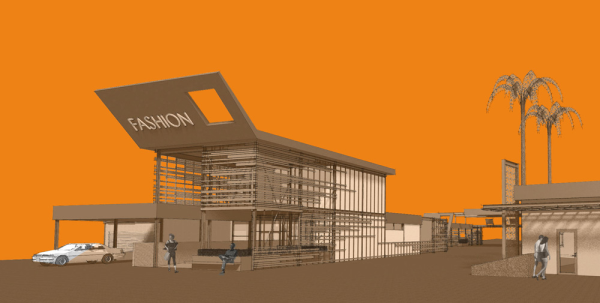Unveiling the Comprehensive Providers Provided by Commercial Architects for Modern Advancement
Commercial Architects offer a crucial function in modern advancement projects. They blend design looks with capability while sticking to governing demands. Their experience prolongs past simple construction, including sustainable methods and innovative innovations. As they navigate intricate zoning legislations, Architects work together with numerous stakeholders to bring visions to life. This diverse approach questions concerning the developing function of Architects fit modern-day areas and the impact of their deal with future developments.
Understanding the Duty of Commercial Architects in Modern Advancement
In contemporary metropolitan landscapes, Commercial Architects play a critical function fit practical and visual spaces that meet varied business requirements. Their experience expands past plain style; they browse complicated zoning legislations, developing codes, and environmental regulations. By working together with customers, they recognize specific requirements, making sure that each task aligns with the customer's vision while likewise taking into consideration useful facets such as sustainability and cost-effectiveness. Commercial Architects are experienced at integrating cutting-edge technologies and products right into their styles, boosting both the functionality and power performance of buildings. They perform thorough website evaluations to analyze the possible challenges and opportunities provided by a location. In addition, efficient interaction with professionals and various other stakeholders is important, ensuring that the task proceeds efficiently from perception to conclusion. Eventually, Commercial Architects contribute in producing rooms that not just accomplish sensible objectives however additionally add to the total personality and vibrancy of urban environments.
Concept Design: Changing Concepts Into Fact
Idea style serves as an important phase in Commercial design, where cutting-edge layout options arise from creative thinking. This process counts on collaborative ideation, uniting varied perspectives to refine and improve preliminary principles. As ideas take shape, they change from abstract concepts right into tangible architectural facts.
Innovative Design Solutions
Transforming ideas into reality is the hallmark of ingenious style services in Commercial design. These solutions mix imagination with functionality, attending to the one-of-a-kind demands of modern growths. By leveraging advanced modern technologies and lasting methods, Architects craft rooms that are not only aesthetically attractive but additionally efficient and versatile. Emphasis on user experience drives the layout process, guaranteeing that environments foster productivity and partnership. Each project gain from a tailored approach, where concepts are thoroughly developed to mirror the customer's vision while taking into consideration future fads. Ingenious layout remedies also focus on adaptability, allowing for alterations over time as company demands progress. Inevitably, these techniques improve the total worth of Commercial spaces, making them crucial in today's affordable landscape.

Collaborative Ideation Process
Partnership acts as the backbone of the ideation procedure in Commercial design, promoting creative thinking and technology amongst varied stakeholders. Architects, clients, engineers, and neighborhood members participate in vibrant conversations, guaranteeing that all viewpoints are thought about. This comprehensive method permits the exploration of various style ideas, urging distinct services that straighten with the job's vision. With workshops and conceptualizing sessions, ideas evolve and fine-tune, transforming first ideas right into substantial styles. Innovation also plays a pivotal duty, with devices such as Structure Information Modeling (BIM) helping with real-time partnership and adjustments. Ultimately, this joint ideation process not just boosts the style end result yet additionally cultivates a feeling of ownership and financial investment among all events involved, resulting in successful Commercial growths.
Zoning Evaluation: Browsing Rules and Conformity
As designers commence on brand-new projects, recognizing zoning guidelines is vital to making certain compliance and avoiding costly delays. Zoning evaluation plays an important duty in this process, as it entails assessing neighborhood zoning laws that dictate land use, constructing height, thickness, and troubles. Commercial Architects have the expertise to browse these complex guidelines, aiding customers determine permissible usages and any necessary variations.
Sustainable Style Practices: Structure for the Future
Lasting design methods are significantly essential in the domain of Commercial architecture, specifically as environmental issues proceed to rise. Architects focus on environment-friendly materials, energy-efficient systems, and design methods that decrease waste and environmental influence. Including renewable resource resources, such as solar panels and wind turbines, allows structures to generate their very own power and decrease dependence on fossil fuels.Furthermore, sustainable style stresses the significance of interior ecological top quality. This includes using all-natural light, boosting ventilation, and choosing safe products to boost passenger wellness and performance. Green roofing systems and living wall surfaces are likewise popular functions that add to biodiversity and metropolitan cooling.Additionally, Commercial Architects often integrate water conservation techniques, like rain harvesting and drought-resistant landscaping. Via these innovative strategies, they Going Here create areas that not just meet contemporary needs yet also promote a lasting future, attending to the growing demand for responsible advancement in the modern-day globe.
Task Administration: Ensuring Timely and Effective Implementation
Reliable task management is important for making sure that Commercial style jobs are completed promptly and within budget. This function encompasses a series of duties, including the control of various stakeholders, timelines, and sources. Commercial Architects leverage their competence to create thorough job strategies that detail important turning points and deliverables, enabling organized development tracking.Regular interaction among employee and clients is critical, cultivating openness and facilitating punctual decision-making. Danger monitoring techniques are also utilized to recognize potential difficulties early, making it possible for aggressive options to be developed. By using sophisticated job management Get the facts tools, Architects can keep track of task performance in real-time, making modifications as needed to keep efficiency.
Interior Decoration: Producing Functional and Aesthetic Spaces
Inside layout plays a crucial role in improving both performance and looks within Commercial areas. Efficient area preparation can optimize process and improve individual experience, while visual style concepts add to a visually appealing atmosphere - commercial architects. Together, these elements produce areas that are not just practical but likewise inspiring
Area Planning Efficiency
While making best use of the energy of offered area, Commercial Architects prioritize room preparation effectiveness to develop both useful and visually pleasing atmospheres. This method involves mindful analysis of the spatial format to assure excellent usage of every square foot. Architects consider elements such as workflow, availability, and all-natural light to enhance usability. By strategically putting furniture, tools, and workstations, they assist in motion and interaction amongst individuals, promoting performance. Furthermore, zoning different areas for specific features helps in managing noise and personal privacy, developing an unified atmosphere. Via reliable area planning, Commercial Architects can transform constraints right into possibilities, ensuring that each room fulfills the diverse requirements of its passengers while adhering to regulatory needs and sector requirements.
Aesthetic Style Concepts
Aesthetic design principles play an essential role in forming environments that are not only functional yet also aesthetically enticing. These principles direct Commercial Architects in creating spaces that reverberate with individuals while enhancing brand identification. Key aspects consist of balance, proportion, and consistency, which work with each other to create a cohesive appearance. Shade systems and products are carefully picked to evoke preferred feelings and sustain the total motif. Additionally, illumination plays a crucial duty, influencing state of mind and presence while highlighting building functions. By integrating these concepts, Architects guarantee that areas are not just practical but likewise welcoming and motivating. Inevitably, effective aesthetic style promotes a positive individual experience, encouraging involvement and contentment in Commercial atmospheres.
Collaboration With Stakeholders: Promoting Effective Partnerships
Successful collaborations in Commercial architecture depend upon effective collaboration with stakeholders, making sure that every voice is listened to and valued. This joint method includes interesting different celebrations, including customers, professionals, and community participants, throughout the layout and development process. By fostering open interaction, Commercial Architects can address concerns, gather insights, and straighten the job's vision with stakeholder expectations.The combination of diverse point of views enhances creative thinking and development, leading to more useful and aesthetically pleasing styles. Normal meetings, comments sessions, and workshops facilitate this dialogue, enabling Architects to adjust their plans in action to stakeholder input. On top of that, developing count on through transparency and accountability enhances these partnerships, causing a smoother project execution.Ultimately, the success of contemporary growths depends upon the Architects' capacity to browse and harmonize differing passions, developing a joint setting that advertises common goals and shared success.
Often Asked Concerns
Exactly How Do Commercial Architects Manage Budget Constraints During a Project?

What Types of Software Program Do Commercial Architects Generally Make Use Of?
Commercial Architects frequently use software application such as AutoCAD for drafting, Revit for Structure Info Modeling, SketchUp for 3D modeling, and task management tools like Microsoft Job to enhance collaboration and simplify process throughout the layout process.
Can Commercial Architects Aid With Obtaining Funding for Projects?
Commercial Architects can aid in obtaining financing for tasks by preparing thorough propositions, assisting to verbalize design visions, and offering economic forecasts that can improve the chance of securing required financing from financiers or financial organizations.
Exactly How Do Architects Guarantee Safety And Security During the Construction Process?
Architects ensure security during building by carrying out strenuous style criteria, collaborating with engineers, conducting normal site evaluations, adhering to neighborhood guidelines, and promoting interaction amongst all stakeholders to minimize threats and advertise a secure workplace.
What Ongoing Support Do Architects Provide After Job Conclusion?
After task conclusion, Architects use continuous support with upkeep appointments, efficiency assessments, and style adjustments. They guarantee structures fulfill evolving demands, address potential problems, and maintain conformity with policies, promoting a lasting connection with clients.